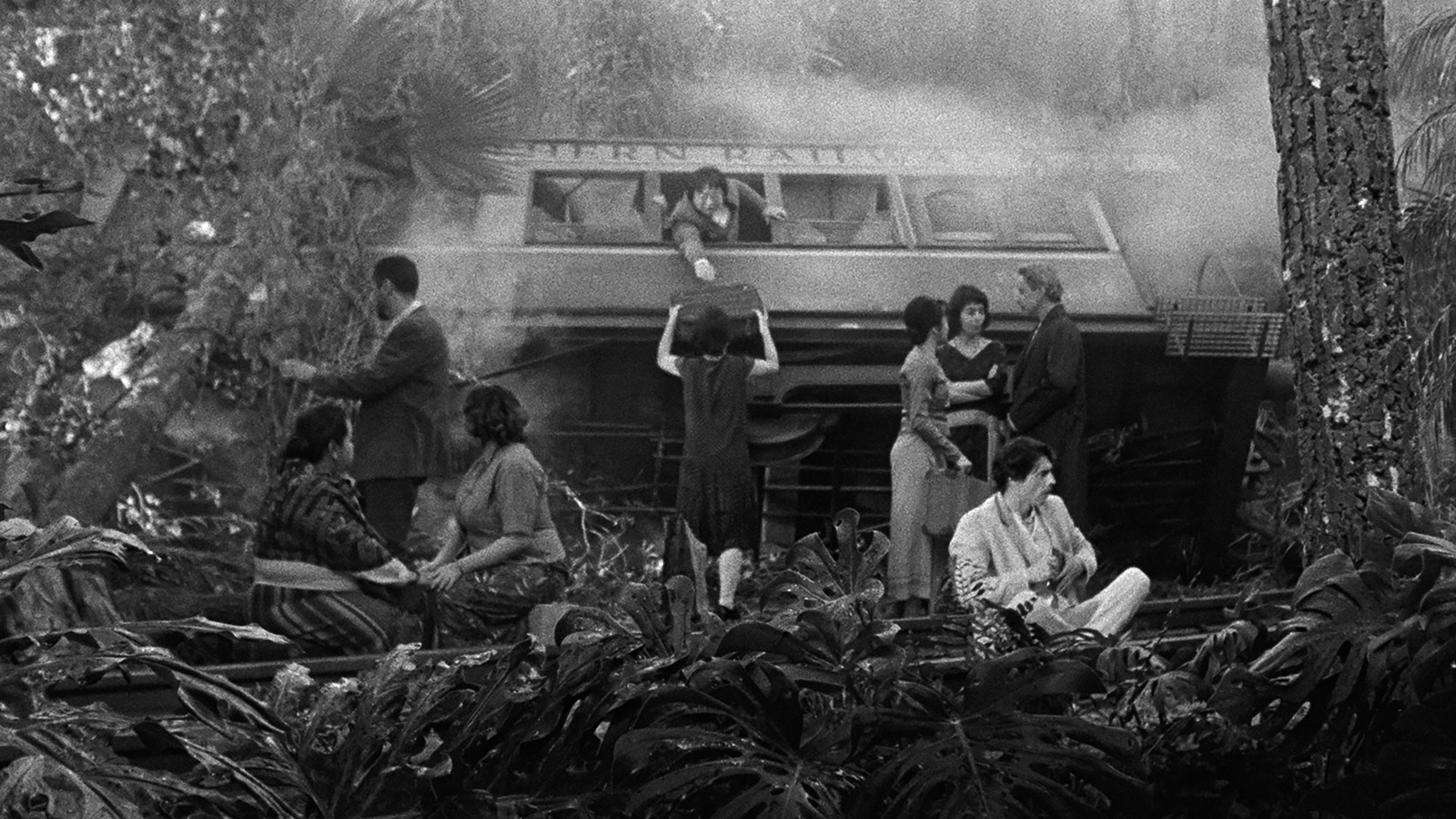This article appeared in the May 31, 2024 edition of The Film Comment Letter, our free weekly newsletter featuring original film criticism and writing. Sign up for the Letter here.

Grand Tour (Miguel Gomes, 2024)
Like several of Miguel Gomes’s previous films, Grand Tour—his sixth feature and first Cannes Competition entry—unfolds in multiple sections and registers, the better to create a whole that exceeds the sum of its parts. In the first half, Edward (Gonçalo Waddington), a functionary of the early-20th-century British Empire stationed in Rangoon, reacts to the imminent arrival of his longtime fiancée, Molly (Crista Alfaiate), by spontaneously embarking on a continental odyssey, from colonial Burma to Singapore, Bangkok, Saigon, Manila, Osaka, Shanghai, and finally, the Chinese hinterlands. The second part finds Molly in determined pursuit, just missing Edward in many of the same locations, as the film takes on a markedly different mood.
True to form for Gomes, the director of Tabu (2012) and Arabian Nights (2015), Grand Tour is defined by formal risk-taking and playfulness largely absent from this year’s Cannes selection. The actors are shot on soundstages, amid painstaking yet patently artificial recreations of a royal palace, a colonial hotel, a derailed train, and a bamboo forest, among other fanciful settings. Scripted scenes taking place a century ago alternate with footage from the present day, captured by Gomes and his crew on 16mm in various countries in two phases: a traveling shoot interrupted by COVID-19 in 2020, and a remotely directed one in 2022. A feat of disjunctive and suggestive montage, it’s a movie that never stays still: traversing time and space at will, vacillating continuously between fiction and reality, and testing and questioning the relationship between cinema and the world.
The day before Gomes was awarded the festival’s Best Director prize, we met to discuss the exploratory, multipart process that gave rise to his latest film.
When you set off on your shoot through Asia—your own grand tour—in early 2020, how much of the concept and the script were already in place?
We knew the structure of the story, and we knew the characters would do the Asian Grand Tour, which was an established touristic path for Europeans in the beginning of the 20th century. The script came later: we wanted to write it after editing the images from the shoot a little bit, and seeing how those images could resonate with the inner world of the characters. We knew from the start that we would also shoot the characters in the studio, and that the images filmed during our journey would somehow be in the film.
Were you looking for anything in particular on this trip? Any types of shots or situations?
First of all, to have fun. That was number one on the list. There is this big Ferris wheel without a motor in Myanmar that was being manually turned by these guys, and we saw it on the first day of shooting. We said, wow, let’s film this—it could resonate with the disorientation and the efforts of Edward, the main character, before he flees. So the criteria were to have fun, to film things that were interesting to us, and to have a diversity in the material. We also had an interest in shooting the different kinds of puppet shows in every region. Some things are staged, of course. For instance, in the Philippines, we invited a bunch of people onto a jeepney and turned it into a moving karaoke party.
Since you and your collaborators—Mariana Ricardo, Telmo Churro, and Maureen Fazendeiro—wrote the script in response to this material, can you articulate what these images conjured for you?
The spectacle of the world. One of the two main characters, Edward, tries to hide in the world, to recede into it, and later he starts to open up to the world, or at least starts to think more about Molly, his fiancée—the woman he’s trying to avoid. As he does, the images become something else. They start to have a different mood: more melancholic, more peaceful. In the second half of the film, with Molly, she’s smart, she has lots of joy, she changes more. The images are funnier, more enjoyable, but they also get darker. Of course, in the process of editing, everything kept changing all the time.
The film makes the viewer quite conscious of the potential of landscapes in cinema. I thought of fûkeiron, or landscape theory, which is associated with a group of radical Japanese filmmakers who emerged in the ’60s and ’70s—notably Masao Adachi, whose film A.K.A. Serial Killer shows a series of locations that its unseen protagonist may have passed through in his life.
I don’t know that film, but there’s a connection with what I intended here. When we show landscapes or actions of the real world, it’s to put the viewer in the position of placing the characters in space. The voiceover tells us what Molly is feeling or what Edward is doing, and it never exactly corresponds to what you see. You assume the position of someone hearing a story, the basic principle of all fiction—the kid listening to bedtime stories, imagining dragons and impossible things in the real world. In Arabian Nights, I wanted to do a portrait of a certain moment in my country, and I needed lots of reality to shoot: things that are happening, that are not staged. But it’s complemented by the imaginary, a parallel world that is not real but real in our minds because it’s something we have the urge for: to create something fictional out of what we live.
What is the appeal of studio shooting for you?
I was a bit worried because I like to lose control. I don’t like to create a bubble for shooting; I like people to just appear in front of the camera, and this was the opposite. We even had to create sunlight in the studio. But I protected myself by saying, “Don’t ask me how many shots I’m going to do, don’t ask me if we can shoot from this side and not the other, just put up the lights and I’ll handle the rest, and maybe change my mind as we go.” It was different from working on locations, but in the end, I enjoyed it.
I understand that you had to pause the location shoot in February of 2020 just as you were about to travel to China, and that you ended up directing the Chinese exterior scenes remotely. Can you describe that setup?
This was another unexpected way of shooting because of the COVID lockdowns. Our Chinese producer said we could go to China, but there would be a three-week quarantine. I asked him, can I smoke? And he said, I don’t think so. That was too big of a sacrifice for cinema, so we explored how we could have a completely Chinese crew, with me in Lisbon directing long-distance. We did a lot of technical work in order for me to have live-feed images, and installed a couple of screens with a general image of the place and also the monitor of the 16mm camera. Lots of screens, lots of ways to communicate. I was able to see how the shooting was going in Shanghai or wherever, and tell the DP when I wanted him to move the camera. It was strange—they would break for lunch and ask what I was eating, and it was 4 a.m. in Lisbon. I was stuck in a rented house while they were traveling thousands of kilometers. I had always planned to have the studio part shot by a Portuguese DP, Rui Poças, and the trip through Asia by an Asian DP, Sayombhu Mukdeeprom. But because of the lockdown and the closed borders in China, we also had this third DP, Gui Liang, who I’ve still never met in person.
Maybe there’s something appropriate about this physical distance: Your two protagonists are never in the same place, and never share a scene.
There was another version of the film. They met in a dream, but it was not a good scene. What we have now is like a strange screwball comedy. Normally Katharine Hepburn is next to Cary Grant, and here the two leads don’t appear together.
In the press conference, you talked about a W. Somerset Maugham text as well as your own marriage [to filmmaker Maureen Fazendeiro, a co-writer of Grand Tour and co-director with Gomes of The Tsugua Diaries (2021)] as starting points for the film.
In Somerset Maugham’s The Gentleman in the Parlour, which is a collection of his travel writing through Southeast Asia, he tells a joke about men and women, men being cowards and women being stubborn when it comes to marriage. Maybe I was sensitive to this question for personal reasons as I was recently married. My name is Miguel Eduardo. I’m not Edward, I hope, but I’m a little bit like him. And Molly is not so different from Maureen.
Maureen doesn’t laugh like Molly, who has a very distinctive, eruptive laugh.
This laugh was the first thing the actress, Crista [Alfaiate], and I created together. I showed her some films from the ’40s with Katharine Hepburn, not because Hepburn laughed in a particular way, but to get the mood and the joy of the characters. This silly laughter gives Molly some definition early on.
Tabu was also set in a colonial context. In Grand Tour, colonialism is not front and center, but there is the line about empires ending…
Said by a guy who’s smoking opium, so I would not trust him too much [laughs]. But it’s true—if you shoot in a studio-constructed post office and you cut to the real post office in Saigon, I don’t have to make much effort for a historical comment or reference. It’s inevitably present. But in Tabu, it was the Portuguese Empire, and this is the British Empire. I’m not playing at home. It’s not the center of the film, but it’s present.
Watching it a second time, I was struck by how many potential obstacles you set up for the viewer. In the collision of present-day documentary footage and period studio scenes, but also in the play with language and anachronism and various forms of artifice, the film is constantly breaking the rules of realism.
Which is nice for me, because I think cinema makes too much effort to convince audiences that they’re seeing something of this world. But we’re not; we’re seeing the parallel world of cinema, with different laws. I hope it’s a world that puts us in a better condition to connect with the real world, with ourselves and other people, but it’s a different world and I want it to look like a different world. As I’ve said before, all of my films are remakes of The Wizard of Oz. That’s the basis of cinema. Dorothy goes from Kansas to the world of cinema, and you have to create some kind of relation between them, and this is my job in my films. Nowadays there’s an understandable desire to try to fix up the world in cinema, which I value, but I think it can be kind of impossible. You cannot fix the world with cinema. But you can open the minds of people. And then they can maybe try to fix up the world.
For almost a decade now, you’ve been developing a project called Savagery [based on the Brazilian literary classic Os sertões (1902), about a bloody war in the Bahia backcountry in the 1890s], which has been described as a larger-scale film. Will you be returning to it?
Yes. There was a moment when I thought it would be impossible. The conditions were difficult because of the Bolsonaro government in Brazil, which stopped public financing of cinema. With Grand Tour in Cannes, I already feel the difference in the way people are interested in supporting my work. Savagery is big in the sense that my films can be big, going from very small, intimate, almost ethnographic things to battle sequences with horses and cannonballs. I want to mix the two scales and the two worlds, the world of Flaherty and the world of Kubrick. I think that could be interesting.
Dennis Lim is the artistic director of the New York Film Festival and the author, most recently, of the Hong Sangsoo monograph Tale of Cinema (2022).




